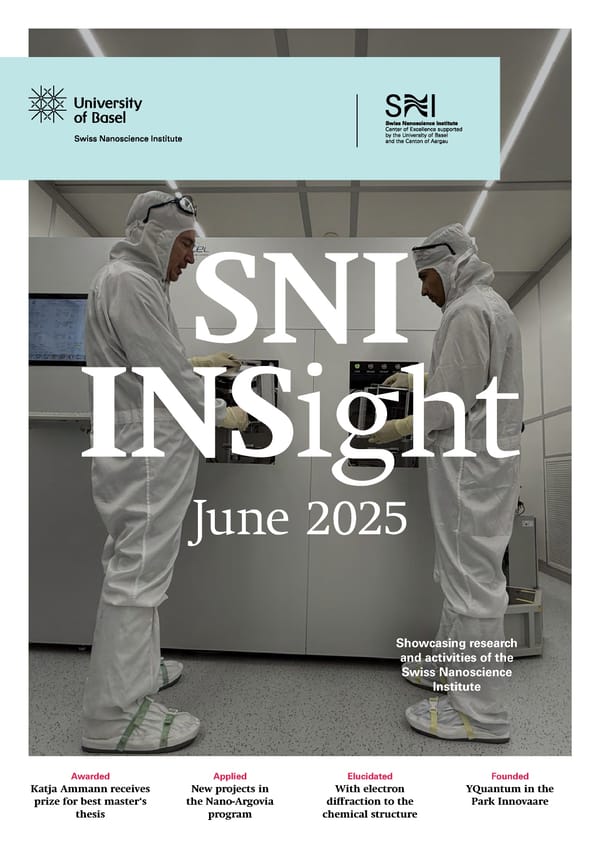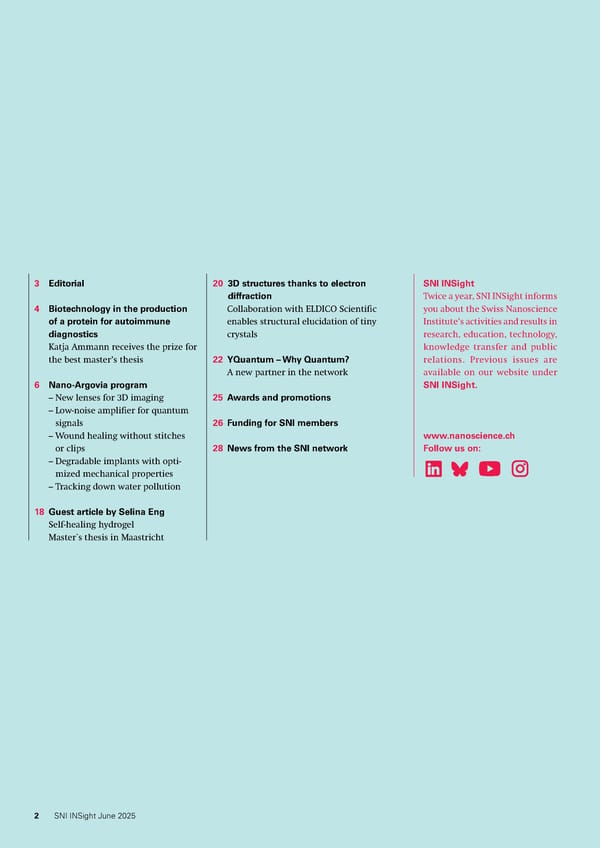SNI Insight - 2025 June
This issue provides insights into research and activities at the Swiss Nanoscience Institute, highlighting new projects and achievements.
Applied New projects in the Nano-Argovia program Founded YQuantum in the Park Innovaare Elucidated With electron diffraction to the chemical structure Awarded Katja Ammann receives prize for best master‘s thesis SNI INSight June 2025 Showcasing research and activities of the Swiss Nanoscience Institute
3 Editorial 4 Biotechnology in the production of a protein for autoimmune diagnostics Katja Ammann receives the prize for the best master’s thesis 6 Nano-Argovia program – New lenses for 3D imaging – Low-noise amplifier for quantum signals – Wound healing without stitches or clips – Degradable implants with opti- mized mechanical properties – Tracking down water pollution 18 Guest article by Selina Eng Self-healing hydrogel Master`s thesis in Maastricht 20 3D structures thanks to electron diffraction Collaboration with ELDICO Scientific enables structural elucidation of tiny crystals 22 YQuantum – Why Quantum? A new partner in the network 25 Awards and promotions 26 Funding for SNI members 28 News from the SNI network www.nanoscience.ch Follow us on: SNI INSight Twice a year, SNI INSight informs you about the Swiss Nanoscience Institute’s activities and results in research, education, technology, knowledge transfer and public relations. Previous issues are available on our website under SNI INSight. 2 SNI INSight June 2025
Dear colleagues and nanoenthusiasts, As summer gets underway, we’re de- lighted to present the latest edition of SNI INSight — with a fresh design and the same fascinating content that you’re used to. As always, we report on exciting de- velopments and news from the network of the Swiss Nanoscience Institute (SNI). In the first highlight of this edition, we introduce readers to Katja Ammann — the winner of last year’s prize for the best master’s thesis in nanosciences. Am- mann carried out the research for her excellent thesis at BÜHLMANN Laborato- ries, and her supervisor was Daniel Rick- lin from the Department of Pharmaceu- tical Sciences. Practical applications are immedi- ately apparent in the five new Nano-Ar- govia projects that the SNI has sup- ported since the start of this year. We take a concise look at these projects, in which researchers from our network collaborate with industry partners to deliver concrete solutions — demon- strating the added value of such collab- orations for participating companies. Projects on the road to practical ap- plications also include start-ups that have emerged from the SNI network. One well-established example is ELDICO Scientific, whose electron diffractometer supports researchers with the structural elucidation of chemical compounds — including the group led by Christof Sparr from the Department of Chemistry of the University of Basel, as reported in this edi- tion. For the company YQuantum, in which Christian Schönenberger is directly involved, this journey is just beginning. We spoke to CEO Christian Jünger — who many of you will undoubtedly know from his time at the Department of Physics in Basel — to learn more about this fledgling undertaking. At the end of this issue, we provide a brief overview of new research projects that SNI members have started in recent months. We then conclude by summariz- ing the main news from the last few months and give you an overview of events and scientific findings from our network. I hope you enjoy this edition of SNI INSight and I would like to thank you for your continued interest in the remark- able world of the nanosciences. Have a great summer! Kind regards, Prof. Martino Poggio, SNI director 3 SNI INSight June 2025
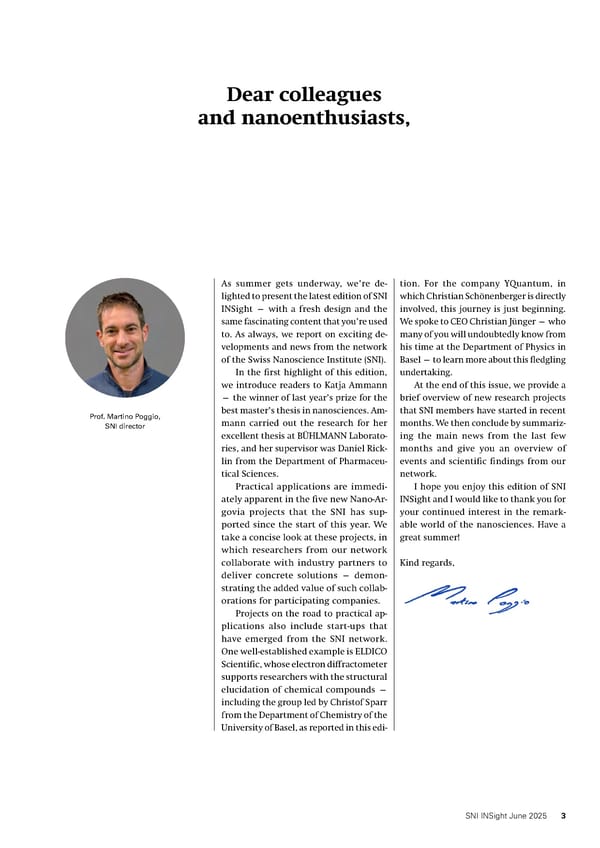
Like many other nanoscience students, Katja Ammann chose to study nanosci- ences because she couldn’t decide be- tween chemistry, biology and physics – she wanted to study them all. Through the block courses she attended and her two projects, she ultimately found that she was particularly interested in applied pharmaceutical research. For her mas- ter’s thesis, the young researcher from Thurgau also wanted to gain experience in industry — not only because it was im- portant to her to make a positive contri- bution to society but also to improve her chances on the job market after complet- ing her studies. “It was thanks to our program coordi- nator, Dr. Anja Car, that I came to work at BÜHLMANN Laboratories AG,” explains Ammann. “Anja was in touch with Dr. Mi- chael Gerspach, who had studied nano- sciences several years ago. Gerspach now leads the Specialty Products Development group at BÜHLMANN Laboratories AG and regularly lectures on applied nanotech- nology in industry here in Basel. He also made sure that I could do my master’s Biotechnology in the production of a protein for autoimmune diagnostics Katja Ammann receives the prize for the best master’s thesis Applied research combined with experience in industry: These were Katja Ammann’s goals for her master’s thesis in nanosciences. She succeeded in these objectives with her project at BÜHLMANN Labo- ratories AG. Ammann is also receiving the prize for the best master’s thesis in nanosciences at the University of Basel in 2025. Katja Ammann completed her master’s thesis at BÜHLMANN Laboratories AG. thesis at BÜHLMANN Laboratories AG. From a selection of the projects he pre- sented, I then chose one that would allow me to do research on a protein that plays a key role in an autoimmune disease.” Sustainable protein production In the autoimmune disease in question, the body’s immune response is targeted directly at the protein. Medical laborato- ries can already detect the disease using an “ELISA” test, in which the protein is attached to a microtiter plate and patient serum is added to it. If the serum contains antibodies against the protein, these will bind to the attached protein and can therefore be detected. Until now, the re- quired protein has been isolated from human tissue. “It would be more sustain- able, however, if we could produce the protein using bacterial or cell cultures with the help of recombinant protein ex- pression,” says Ammann. “And that was precisely what my work sought to do.” Amman began by processing and ma- nipulating the genetic template for the protein at the DNA level so that it could 4 SNI INSight June 2025
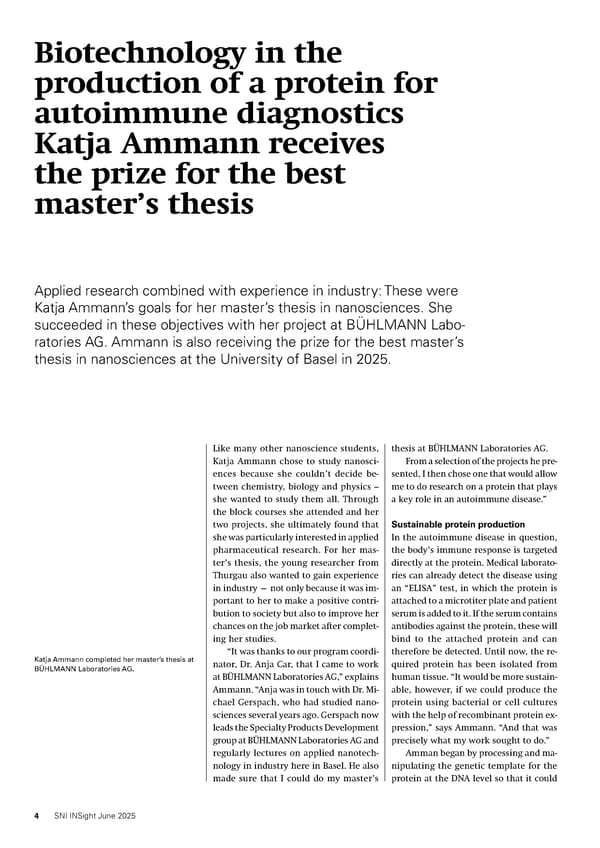
be smuggled into mammalian cells as a blueprint for the protein. The cell cul- tures modified in this way were then able to produce the protein under standard- ized conditions in the lab. From the su- pernatant liquid, Amman was able to iso- late the biotechnologically produced pro- tein and purify it in several steps — as purity is vital for the specific test. This might sound simple, but it is ac- tually a complex process entailing numer- ous intermediate steps in which there are different influencing factors and poten- tial problems. Amman succeeded in pro- ducing and purifying the protein in cell cultures; however, some of the sugar structures bound to the protein, which are essential for diagnostic testing, were missing. Despite further experiments, Amman was unable to fully resolve this issue. Valuable screening method “Katja’s master’s project did, however, yield an extremely valuable ‘by-product,’ which we continue to use on a regular basis,” says Dr. Christina Bauer, who was Amman’s supervisor. “Specifically, she developed a quick and simple screening method that we can use to test whether biotechnologically produced proteins are suitable for diagnostic detection.” In this test, researchers can produce their proteins from cells on a small scale, break the cells down, separate them us- ing gel electrophoresis, and then incu- bate them directly with patient serums in order to investigate their binding to the protein. “This rapid screening tech- nique, which is based on the western blot method, saves us a great deal of work be- cause we don’t need large amounts of the protein for detection — and there’s also no need to purify it,” explains Bauer. The right choice For Ammann, the aim of completing her master’s thesis in industry was an excel- lent choice: “I received first-rate supervi- sion, both from the team at BÜHLMANN Laboratories AG and from Professor Daniel Ricklin from the Department of Pharma- ceutical Sciences at the University of Ba- sel,” she says. “Above all, the project taught me that a lot of research is about looking for reasons why something didn’t go to plan. Even if something doesn’t work out, the insights obtained are still valuable,” she says, summarizing her experience. Amman’s hope of finding a job in indus- try after her master’s degree in nanosci- ences has also been fulfilled. As a research associate at LimmaTech Biologics AG (Schlieren), she is still working in protein engineering — albeit with a view to iden- tifying vaccines against antibiotic-resis- tant bacteria. She therefore continues to pursue her ambition of working on applied research, contributing ideas of her own, enjoying herself, and having a positive impact on humanity all at the same time. We would like to wish her all the best for the future and congratulate her on her excellent master’s thesis! As a by-product of her work, Katja developed a screening method based on the western blot method. This can be used to test whether biotechnologically produced proteins are suitable for diagnostic tests. “Having Katja in the lab was a real asset for us.” Dr. Christina Bauer, senior scientist, BÜHLMANN Laboratories AG Further information: Video with Katja Ammann BÜHLMANN Laboratories AG Molecular Pharmacy Prof. Ricklin, University of Basel 5 SNI INSight June 2025
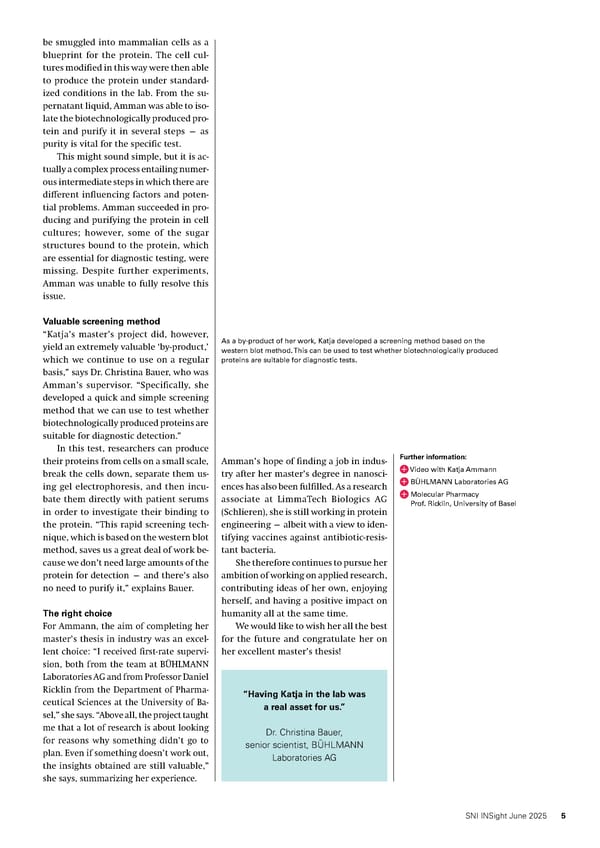
6 SNI INSight June 2025
Five new Nano-Argovia projects launched At the beginning of the year, researchers started work on five new application-oriented Nano-Argovia projects. In three of these projects, scientists from the SNI network are collaborating with companies from the canton of Aargau. After a long break, com- panies from the canton of Solothurn are once again represented in two of the projects. Find out here which innovative approaches the researchers are investigating this year. 7 SNI INSight June 2025
New lenses for 3D imaging In the Nano-Argovia project Nano Diffractive Optics, an interdiscipli- nary team is developing optical elements on a nanometer scale that can be used for three-dimensional imaging in an optical coherence tomography (OCT) system. Concentric ring lenses The researchers are focusing on the production of so-called fraxicon lenses. Unlike a normal lens, these lenses are not smooth or spherical but rather consist of numerous thin, concentric rings. These rings have jagged or stepped structures that deflect light — in this case, laser light — into a narrow beam (a Bessel beam) that remains the same over a long distance. In this two-year project, led by project manager Professor Bojan Resan (University of Applied Sciences and Arts Northwestern Switzerland FHNW, School of Engineering and Environment), the researchers plan to produce fraxicon lenses with a sharp tip in the sub-micrometer range using direct laser writing techniques. Determine the potential of mass production To this end, the team is analyzing and optimizing each process step so that the lenses can subsequently be produced in large quantities. The researchers will then test the lenses in a recently developed ul- tra-high-resolution OCT imaging system. The team from FHNW, the Paul Scherrer Institute and the industrial partner XRnanotech is also inves- tigating how various optical gratings can be produced using different lithography techniques. These grat- ings need to have numerous lines per millimeter and deflect either infrared or UV rays depending on their structure. Gratings of this kind are already well estab- lished, but the production methods used today are difficult, costly and inflexible. In the Nano Diffractive Optics project, the researchers want to explore the potential for mass production through direct writing or nanoimprinting. Collaboration between: FHNW School of Engi- neering and Environ- ment Paul Scherrer Institute XRnanotech GmbH (Villigen) Further information: Nano-Argovia program PSI FHNW XRnanotech “We’re proud to be participating in the Nano-Argovia program, which will signifi- cantly accelerate our R&D and product prototyping efforts, putting XRnanotech in a position to access new markets within the next year.” Dr. Gérard Perren, XRnanotech AG Nano-Argovia Project 8 SNI INSight June 2025
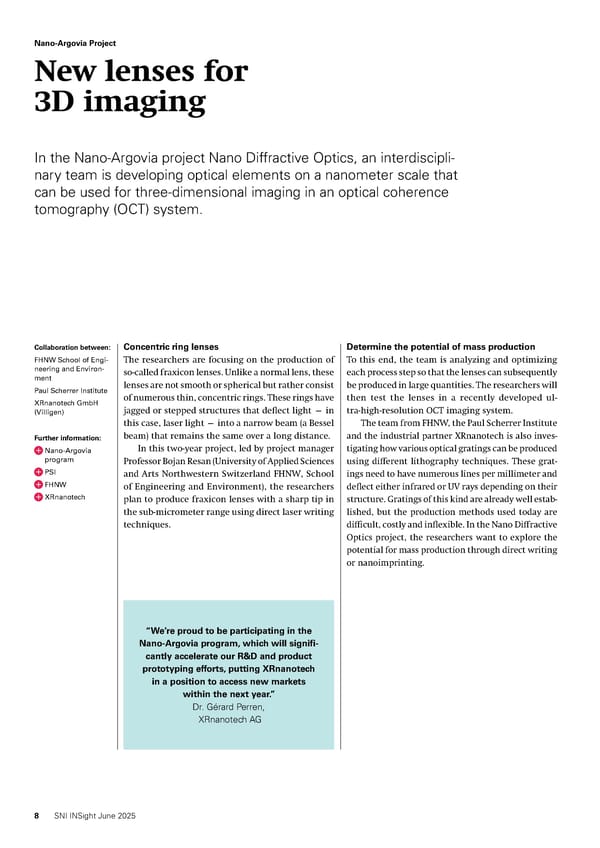
In the Nano-Argovia project Nano Diffractive Optics, the interdisciplinary team is focusing on the production of fraxicon lenses. These consist of numerous thin, concentric rings which, thanks to their jagged or stepped structures, deflect laser light into a narrow beam that remains the same over a long distance. (Image: FHNW and XRnanotech) Annual Meeting 2025 The SNI Annual Meeting will take place from 10–12 September at the Seerose Resort & Spa on Lake Hallwil in Meisterschwanden. We`re already looking forward to an exciting program and a lively exchange within our network! The SNI network meets at the Annual Meeting to exchange ideas and make new contacts. 9 SNI INSight June 2025
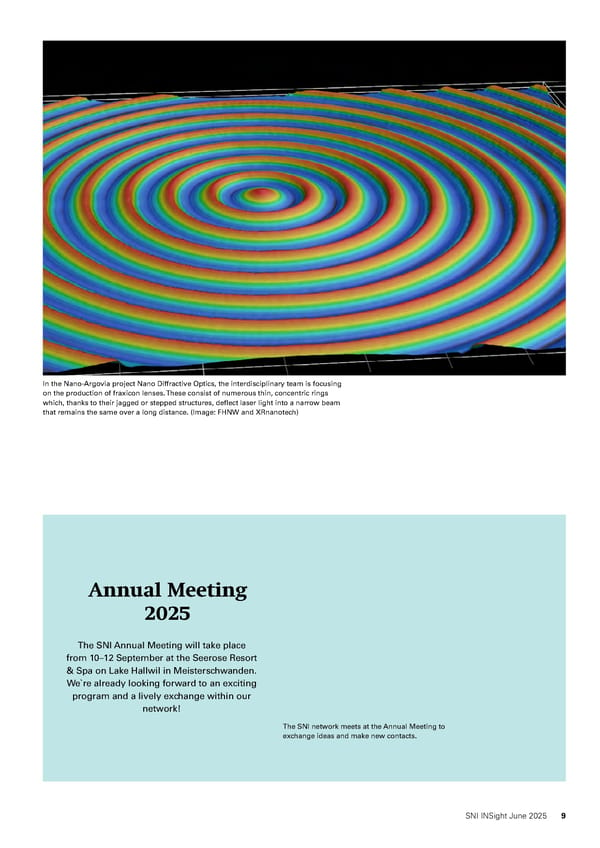
Low-noise amplifier for quantum signals As part of the Nano-Argovia project QAmp, researchers from the start-up YQuantum, the Paul Scherrer Institute PSI and the University of Basel are working together on a key building block for the next generation of quantum computers: extremely low-noise amplifiers for quantum signals. Signal amplification At the heart of this technology is a “traveling-wave parametric amplifier” (TWPA), which is needed to convert weak signals from quantum computers into classical electrical signals — with the least possible additional noise. The aim of the project is to develop an amplifier that has as little physical influence on the signals as possible and therefore allows the pre- cise and scalable reading of qubits. Led by Professor Christian Schönenberger and Professor Andrea Hofmann (Department of Physics, University of Basel), the team is working with indus- try partner YQuantum to develop a new generation of these amplifiers. The devices are based on super- conducting Josephson junctions and use specially developed low-loss structures to amplify signals as efficiently as possible. This work benefits from the partners’ complementary areas of expertise: While the University of Basel handles the characterization of the amplifiers at extremely low temperatures, PSI works with the PICO clean room infrastructure to facilitate production on 8-inch silicon wafers — a major step toward the integration of numerous com- ponents in an extremely small space. Within two years, this ambitious project aims to produce market-ready amplifiers that are not only more compact than current systems but also operate much closer to the absolute quantum noise limit. This should allow the reliable reading of 1,000 qubits — a vital step in the further development and scal- ability of quantum computers. Collaboration between: University of Basel Paul Scherrer Institute YQuantum (Villigen) Further information: Nano-Argovia program Research group A. Hofmann, University of Basel PSI YQuantum “With support from the Nano-Argovia project, we’re able to achieve significant advances in the development of a novel quantum amplifier by working hand in hand with strong partners from the University of Basel and PSI. This promising system is well on the way to becoming a vital product in our portfolio.” Dr. Christian Jünger, YQuantum Nano-Argovia Project 10 SNI INSight June 2025
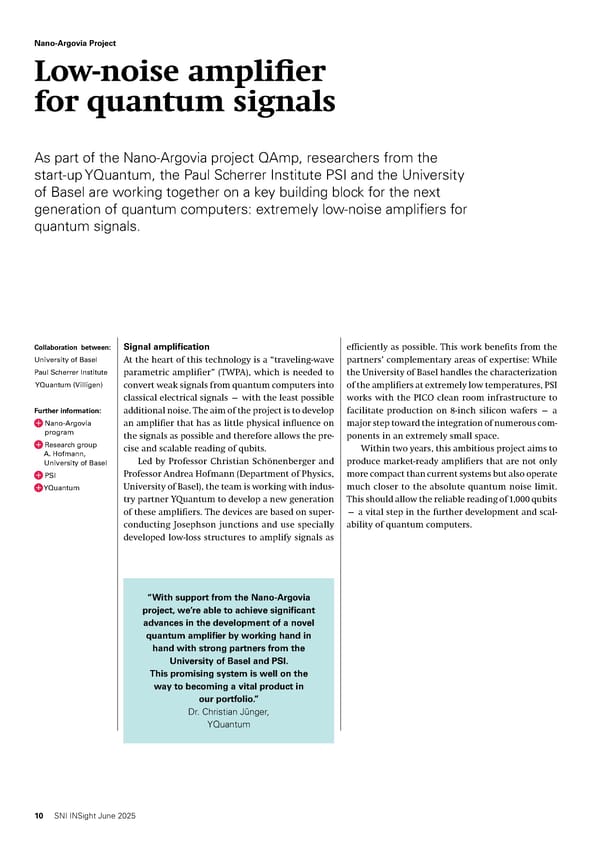
The QAmp team produces the amplifier chips in Park Innovaare’s clean room. A state-of-the-art sputtering unit allows the researchers to apply extremely thin coatings on 8-inch silicon wafers. Nano-Argovia program Submit your new project proposals now! With the Nano-Argovia program, the SNI supports applied nanotechnology research projects. Researchers from companies in Northwestern Switzerland work together with partners from at least two academic institutions from the SNI network to develop solutions for very different nano- technology challenges. Submit your project proposals by September 30, 2025. Information about the Nano-Argovia program and the requirements for applications can be found at www.nano-argovia.swiss 11 SNI INSight June 2025
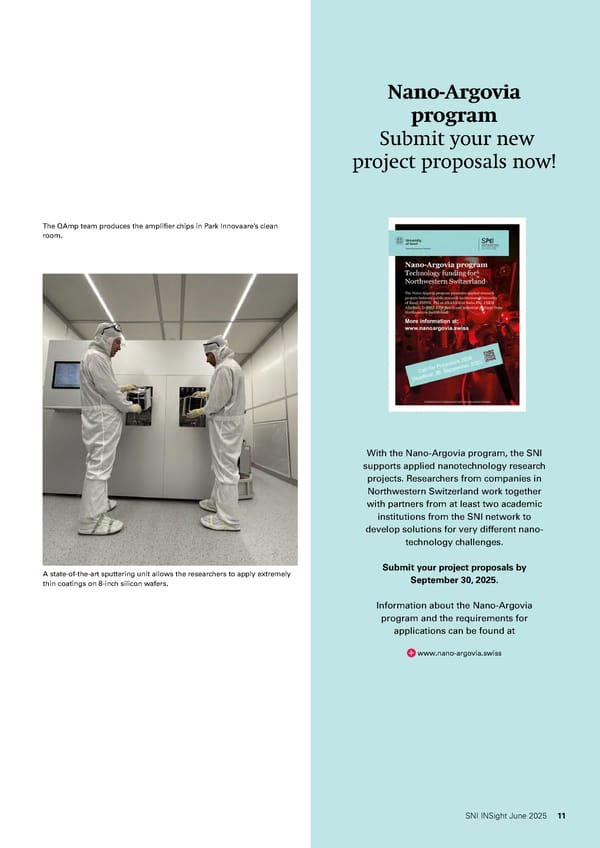
Nano-Argovia Project Wound healing without stitches or clips In the Nano-Argovia project Na-LTS, an interdisciplinary team is developing a tissue plaster that can be used in the mouth to support rapid wound healing with the help of lasers. Support of the healing process Soft tissue in the mouth plays a signifi- cant role in the preservation of teeth and implants. Receding gums are therefore a problem, and serious cases can require the transplantation of mucous mem- brane and connective tissue. In this pro- cedure, oral surgeons take the required tissue from the palate area. Now, a team of researchers led by proj- ect manager Dr. Franziska Koch (Thommen Medical AG) is planning to develop a palate plaster that supports the healing process and minimizes complications in the event of such interventions. The researchers plan to use this plaster in conjunction with a widespread medical technique known as laser tissue soldering. Contained within the plaster are various nanoparticles, which heat up when exposed to a laser of a certain wavelength — while surrounding tissue remains unaffected. Targeted warm- ing leads to the thermal denaturing of pro- teins, which act as biological “glue,” at the desired location. This leads to rapid closing of the wound — with no need for stitches or clips. Prototype development The project team, which comprises Thommen Medical and researchers from the FHNW Schools of Life Sciences and Engineering and Environment, benefits from the industry partner’s long-standing experience. This allows the team to take account of specific regulatory require- ments for medical projects in terms of Researchers experiment with applying the innovative tissue plaster to a pig’s jaw. (Image: F. Koch, Thommen Medical) the choice of materials and nanoparticles right from the outset of this two-year project. The aim is to develop a prototype of the tissue that can serve as a basis for the subsequent product authorization and market launch. Collaboration between: Thommen Medical AG (Grenchen) FHNW School of Life Sciences FHNW School of Engineering and Environment Further information: Nano-Argovia program Thommen Medical AG FHNW School of Life Sciences FHNW School of Engineering and Environment “It’s almost impossible for a medium-sized company to bring the necessary skills for a complex project such as Na-LTS under one roof. Our participa- tion in the Nano-Argovia pro- gram is therefore invaluable to us. It brings together experts in different subject areas, creates synergies and allows us to work together on refining the idea — as well as learning from each other in the process.” Dr. Franziska Koch, Thommen Medical AG 12 SNI INSight June 2025

During the coating process on cylindrical sam- ples in the electrolyte, plasma discharges gener- ate sparks on the sample surfaces that are visible to the naked eye. (Image: T. Imwinkelried, RMS Foundation (Bettlach)) Nano-Argovia Project Degradable implants with optimized mechanical properties In the Nano-Argovia project NanoPed, researchers are developing resorb- able metallic implants for neurosurgi- cal applications. These novel implants aim to reduce the number of requi- red surgeries, thereby improving the healing process. Resorbable materials At present, neurosurgery predominantly makes use of non-resorbable metallic im- plants. These permanent materials can lead to adverse effects over time and may need to be removed in follow-up surgery. However, every additional intervention carries further risks of complications and imposes a burden on both the patient and the healthcare system. In the Nano-Argovia project NanoPed, researchers led by project manager Dr. Romy Marek (University of Applied Sci- ences and Arts FHNW, School of Life Sci- ences) are now investigating materials that fully degrade in the body and that are suitable for neurosurgical procedures. Due to the disadvantages of existing re- sorbable implants made from polymers, the interdisciplinary team is focusing on degradable metals made up of a magne- sium alloy. The industrial partner in the project, Kairos Medical AG, can provide an alloy whose strength and formability can be adjusted to meet different mechanical re- quirements. This is achieved using na- noscale magnesium-calcium (Mg2Ca) par- ticles. Optimized implants In the project, which is planned to run for two years, researchers from FHNW, ANAXAM, Kairos Medical and Cantonal Hospital Winterthur will now examine how the size and distribution of the Mg2Ca particles in the alloy influence the material’s degradation in the body. They will also analyze a special protective coat- ing designed to chemically stabilize the implant surface and thereby further op- timize its degradation behavior. The aim is to identify the coating properties that slow down degradation and to establish how the coating behaves under mechan- ical stress. Overall, the project aims to develop better and safer implants for neurosur- gery — with fewer interventions and im- proved healing outcomes. Collaboration between: FHNW School of Life Sciences ANAXAM Kairos Medical AG (Bettlach) Cantonal Hospital Winterthur Further information: Nano-Argovia program FHNW School of Life Sciences ANAXAM Kairos Medical AG Kantonsspital Winterthur “Neurosurgical procedures are often particularly stressful for patients. Avoiding follow-up surgery would therefore relieve the burden not only on the healthcare system, but also on patients in particular. NanoPed is a strategically important project for us, driving the devel- opment of next-generation metallic, resorbable implants and significantly strengthening our position when it comes to delivering safer and more adap- tive treatments for patients.” Dr. Leopold Berger, Kairos Medical AG 13 SNI INSight June 2025
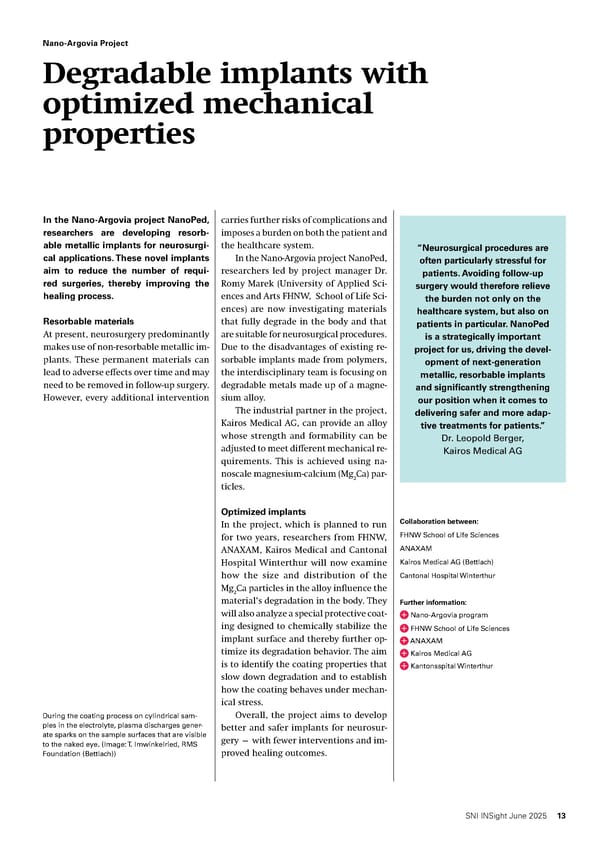
Modified nanoparticles The researchers in the Nano-Argovia project Senamag are using magnetic nanoparticles (MNPs) whose sur- faces are modified with polymer chains. These parti- cles can bind specifically and selectively to certain pollutants that, if they are present in the water, cause the particles to cluster together. These clusters then get caught in a filter and are immobilized by a “mag- netic trap.” In the absence of pollutants, the particles remain small and isolated and can therefore flow through the filter without problems. Cost-effective and efficient The magnetic trap, which consists of a magnet and magnetometer, is responsible for concentrating and detecting the pollutants. The magnetometer mea- sures the magnetic field of the clustered particles but does not register a significant signal in the case of isolated MNPs. Led by Professor Joris Pascal (University of Applied Sciences and Arts FHNW, School of Life Sciences), the researchers are aiming to offer a cost-effective and efficient method for detecting water pollution. In the future, they plan to use several of these detectors in water supply networks to monitor pollution events in real time and track specific pollutants so that they can immediately raise the alarm if pollut- ant limits are exceeded. This could significantly im- prove water quality monitoring on a large scale. Tracking down water pollution In the Nano-Argovia project Senamag, researchers are investigating a cheap and effective system for detecting water pollution. Collaboration between: FHNW School of Life Sciences, FHNW School of Engineering and Environment Mems AG (Birmenstorf) Further information: Nano-Argovia program FHNW School of Life Sciences School of Engineering and Environment Mems AG “Great things are expected from the development of miniature sensors for monitoring drinking water quality. The new measuring technique proposed in the Senamag project is a promising approach as it combines miniaturization, low manu- facturing costs and high performance.” Dr. Daniel Matter, Mems AG 14 SNI INSight June 2025 Nano-Argovia Project
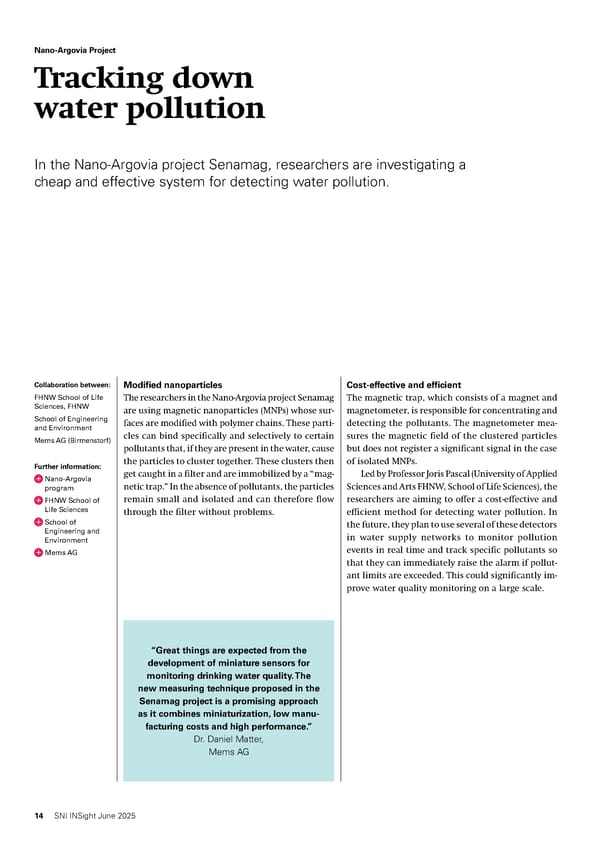
Using a fairly large particle (0.1 mm), the researchers demonstrate the functional principle of their detection system, which they plan to use to detect pollutants in water. The particles they subsequently detect are significantly smaller. (Image: J. Pascal, FHNW) Annual Report 2024 The Annual Report 2024 once again provides a comprehensive overview of the education, research, and knowledge and technology transfer taking place within our network. Readers will also learn about the Nano Technology Center and the outreach team, as well as discovering key SNI statistics and financial reporting. Why not take a look at the report — it’s much more than just dry facts and figures! Animated version Print version Scientific supplement EN 15 SNI INSight June 2025
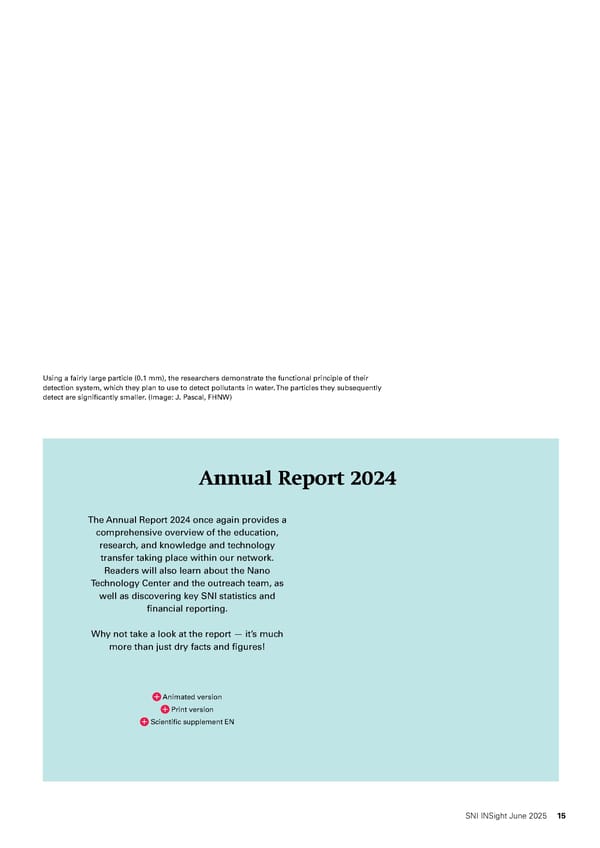
As part of the work, I synthesized and functionalized mesoporous silica nanoparticles (MSNs) and embed- ded them into the hydrogel matrix to create nano- composite systems. These nanoparticles were de- signed to enhance the hydrogel’s mechanical prop- erties. The application of various analytical tech- niques including dynamic light scattering (DLS), zeta potential measurements, transmission electron mi- croscopy (TEM), Fourier-transform infrared spectros- copy (FTIR), and nuclear magnetic resonance spec- troscopy (NMR) then ensured that I obtained exten- sive information about the materials used and was able to evaluate them. One of the most important aspects of the project was optimizing the hydrogel’s pH-responsive crosslink- ing mechanism, which allowed us to control gelation and achieve reliable self-healing behavior. I also tested the final systems for injectability, in vitro sta- bility, and mechanical performance. Rheological analysis provided especially interesting insights into the behavior of the hydrogel under stress, which I explored in detail in my thesis. Positive experience My work contributes to the broader field of bioma- terials by presenting a hydrogel platform that brings Further information: MERLN - Institute for Technology-In- spired Regenera- tive Medicine Nanoscience study program University of Basel Self-healing hydrogel Master`s thesis in Maastricht During my six-month research stay at the MERLN Institute in the Netherlands, I worked on my master’s thesis, focusing on the development of an injectable, self-healing hydrogel with potential applications in regenerative medicine. The aim was to design a hydrogel system based on 8-arm polyethylene glycol, intended for minimally invasive therapeutic delivery while supporting the body’s natural ability to repair bone tissue. For her master’s thesis, Selina Eng wanted to gain experience outside Basel. Maastricht is particularly easy to discover by bike. Guest article by Selina Eng 16 SNI INSight June 2025
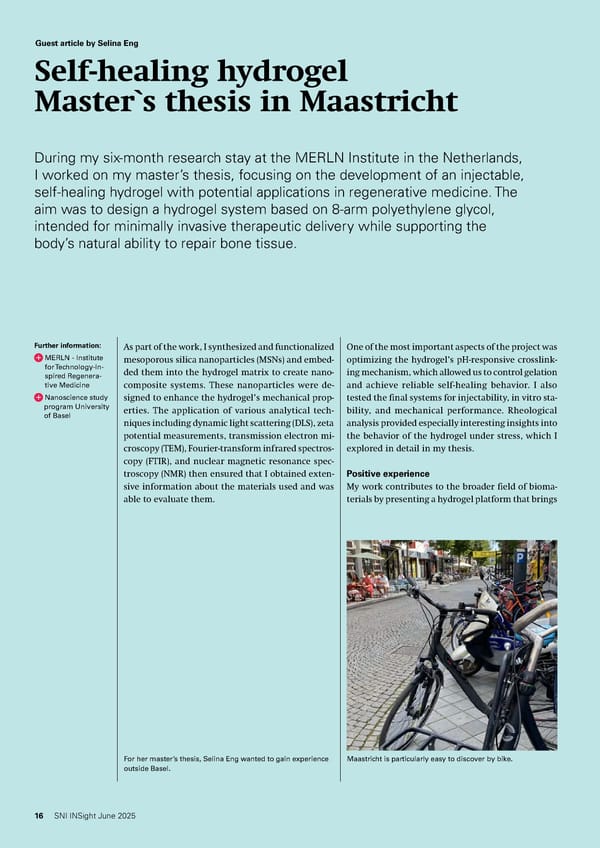
scenery, and a lively international atmosphere, it offered a very pleasant balance to the intensity of lab work. Overall, the stay at the MERLN Institute allowed me to carry out meaningful scientific work in a highly collaborative and innovative environment and to work with some delightful people. I’m very happy that I had this opportunity thanks to the Ar- govia Travel Grant. The hydrogel system based on 8-arm polyethylene glycol is intended for minimally invasive therapeutic delivery while sup- porting the body’s natural ability to repair bone tissue. (Image: S. Eng) together responsiveness, injectability and better mechanical properties. These qualities are increas- ingly important in tissue engineering and regener- ative therapies. The MERLN Institute offered a very helpful and welcoming scientific community in which I could learn much about the field of regenerative medi- cine. The city of Maastricht is a small city in the province of Limburg with considerable charm. With its blend of historical architecture, riverside The synthesized nanoparticles are intended to improve the properties of the hydrogel. (Image: S. Eng) In the small university town of Masstricht (Netherlands), Selina felt very much at home. 17 SNI INSight June 2025
18 SNI INSight June 2025
News from start-ups The SNI and ELDICO Scientific have a number of connections: the foundation for the company was laid as part of a Nano-Argovia project and the SNI is a member of the Experience Center for Electron Diffraction in the Switzerland Innovation Park Basel Area, which was initiated by ELDICO Scientific. Recently, Prof. Christof Sparr’s group was able to elucidate the structure of a new compound thanks to the collaboration in this consortium. More on page 20. 19 SNI INSight June 2025
Network 3D structures thanks to electron diffraction Collaboration with ELDICO Scientific enables structural elucidation of tiny crystals Using electron diffraction in tiny crystal needles, researchers from Basel have succeeded in determining the three-dimensional structure of a compound produced by Professor Christof Sparr’s group using a special synthesis method. The team benefited from access to the Electron Diffraction Experience Center at Switzerland Innovation Park Basel Area, which the SNI offers to its members. Determining the three-dimensional con- figuration of novel molecules is an essen- tial part of modern chemical research — and X-ray structural analysis of single crystals has established itself as the method of choice. If the crystals are too small, not pure enough or not present in sufficient quantities, however, X-ray structural analysis does not always pro- duce the desired results. 3D electron dif- fraction can be helpful in such situations — as demonstrated by an interdisciplin- ary team in a Nano-Argovia project a few years ago. Sophisticated method Back then, the researchers used an elec- tron microscope for their measurements. Now, thanks to the founding of the start-up ELDICO Scientific in 2019 and the continuous development of a specialized 3D electron diffraction measuring device (a 3D electron diffractometer), research- ers have access to a more sophisticated technique. This approach is based on de- flecting electrons from a focused electron beam through the crystal lattice of the examined material in order to produce a characteristic diffraction pattern. This pattern is then fed into special software in order to calculate the arrangement and spacing of atoms in the crystal lattice, re- sulting in a 3D structural model of the molecule in question. The SNI is a member of the consortium behind the Electron Diffraction Experi- ence Center at Switzerland Innovation Park Basel Area, which was initiated by ELDICO Scientific. Accordingly, SNI mem- bers also have access to this innovative technology — and therefore to the struc- tural analysis of a wide range of chemical compounds. Success through electron diffraction Valeriia Hutskalova from Professor Chris- Valeriia Hutskalova from the team of Prof. Christof Sparr (Department of Chemistry, University of Basel) has developed aromatic ring-opening metathesis as part of her doctoral thesis and used it to synthesize completely new chemical compounds. (Image: Department of Chemistry, University of Basel) 20 SNI INSight June 2025
tof Sparr’s team at the Department of Chemistry at the University of Basel has seized this opportunity. As part of her doc- toral thesis, she worked on the develop- ment of novel synthesis methods in order to catalytically break open aromatic rings. To this end, she developed an ap- proach known as “aromatic ring-opening metathesis,” which involves breaking open a highly stable aromatic ring and converting it into interesting new com- pounds. During the reaction, a met- al-based catalyst attacks the aromatic ring to form an intermediate, which in turn leads to the formation of new aromatics. Given the small crystal size of less than 1 μm, however, it was not possible to an- alyze the structures of all the newly syn- thesized compounds using X-ray struc- tural analysis — which led the crystal- lographers Dr. Alessandro Prescimone (University of Basel) and Dr. Christian Jandl (ELDICO Scientific) to consider us- ing electron diffraction. “Sample preparation for the analysis was simple,” says Hutskalova. “The crys- tallographers applied a powder of tiny crystal needles to a transmission electron microscope grating and measured the sample using the ELDICO ED-1 electron diffractometer.” Analysis of the diffrac- tion data and various refinements then allowed the reliable elucidation of the molecules’ 3D structure — with statistical calculations confirming the validity of the results. This work has proven the effective- ness of electron diffraction as an alterna- tive to single crystal X-ray analysis for tiny crystals when it comes to elucidating the 3D structure of a new group of substances. “We assume that electron diffraction will undergo further development and play an increasingly central role in structural analysis in organic chemistry in the fu- ture,” Sparr concludes. Further information: Research group C. Sparr, University of Basel ELDICO Scientific Publication in Nature 638 (2025) Publication in Chimia 79 (2025) The researchers place a powder of crystal needles on a grid, load the grid into a transfer container and place this in the electron diffractometer. Christian Jandl (ELDICO Scientific) selects the correct crystal, centers the device and carries out the measurements. The grid with the sample is rotated step by step so that the electron beam hits the crystal from different angles. The computer then calculates the three-dimen- sional structure of the analyzed compound from the various diffraction images. 21 SNI INSight June 2025
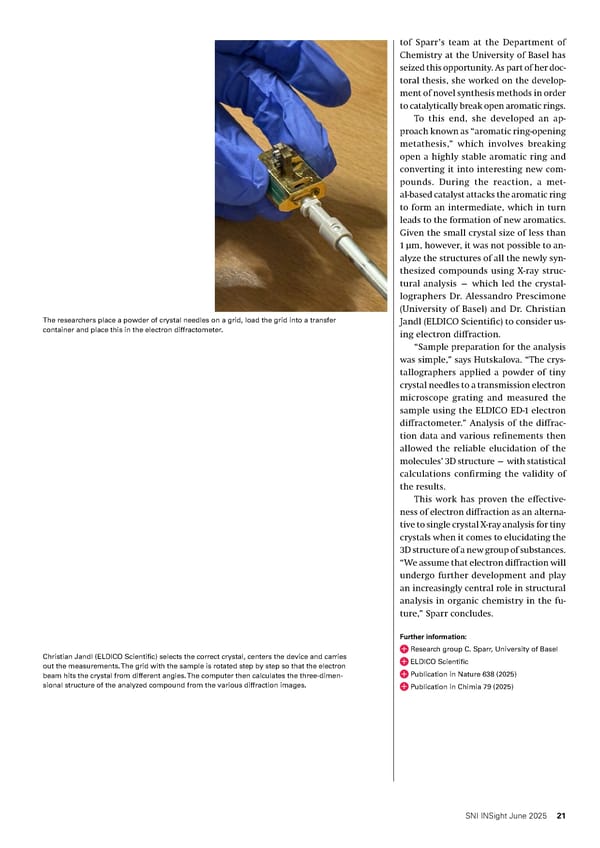
Network YQuantum — why quantum? A new partner in the network YQuantum, a new start-up in the SNI network, has been based at Park Innovaare in Villigen since January 2025. The four-person team behind this fledgling company produces innovative, miniaturized and scalable hardware for quantum computers and is already in the process of delivering its first products to customers. We spoke to YQuantum’s CEO, Dr. Christian Jünger, to learn more about the company. The initial idea of establishing YQuantum emerged about a year ago while Dr. Chris- tian Jünger and Dr. Johannes Herrmann were working at QuantrolOx, a company that seeks to advance the automation of quantum computers. Through extensive contact with hardware manufacturers in the quantum computing sector, the two young scientists discovered that there are hardware gaps when it comes to integrat- ing high-frequency components and quantum objects. “We both have quite extensive and complementary knowledge,” explains Jünger. “Johannes gained considerable experience through his doctoral disserta- tion and postdoc in the fields of high-fre- quency technology and quantum engi- neering at ETH Zurich. Likewise, I worked intensively with superconducting qubits as part of my postdoc at the University of California, Berkeley. With this in mind, we increasingly concluded that we should use our combined knowledge to develop better hardware components, thereby supporting other researchers and compa- nies with the further development of quantum computing.” As their third co- founder, the researchers brought on board the retired Professor Christian Schönenberger, who was director of the SNI for many years and also formerly led the Quantum- and Nanoelectronics group at the Department of Physics at the University of Basel. The team is further enhanced by Dr. Deepankar Sarmah, who also hails from the University of Basel and specializes in nanofabrication and low- temperature quantum transport mea- surements. Great conditions for starting a business At Park Innovaare in the Canton of Aar- gau, the young start-up from the Univer- sity of Basel enjoys ideal conditions for launching a successful business. Proxim- ity to various cooperation partners at the Paul Scherrer Institute and the University of Basel combines with excellently equipped new clean rooms to provide optimum conditions for quickly testing and supplying valuable products. More- over, a research partnership with the Uni- versity of California, Berkeley (USA), al- lows this start-up from the University of Basel to develop prototypes on an inter- national basis by working with leading teams of scientists in the field of quan- tum computing. Necessary miniaturization Specifically, the scientists are working on the miniaturization of various compo- nents needed in quantum computers. For example, Jünger and Herrmann have just applied for a patent on an integrated in- frared filter. Filters of this kind are nec- essary because quantum bits (qubits) — the tiny, extremely sensitive units of a quantum computer — must be protected against interference from the environ- ment. The filter developed by YQuantum ensures that interference in the form of electromagnetic noise, thermal effects or individual photons is attenuated and that the qubits retain their quantum states. It is also significantly smaller than existing filters, which will be a key factor when it comes to realizing a greater number of qubits in the future. “For most concepts of a quantum com- puter, you need very low temperatures close to absolute zero, which are achieved within a cryostat,” explains Jünger. “For every chip with qubits, you then also need numerous high-frequency compo- nents within the cryostats — and all of these components take up space. Building genuinely powerful quantum computers will require far more qubits than in cur- 22 SNI INSight June 2025
The four-person team at YQuantum supports the development of quan- tum computers with miniaturized and optimized components. They were among the 15 finalists for the W.A. De Vigier Foundation’s de Vigier Award and are now also receiving support from Venture Kick. From left to right: Johannes Herr- mann (CTO), Christian Schönen- berger (scientific advisor), Christian Jünger (CEO) and Deepankar Sar- mah (research scientist). The team from YQuantum benefits from outstanding infrastructure at Park Innovaare — for example, when working on the ultra-modern sputtering system, which is used to apply nanometer-thick coatings. Deepankar Sarmah inspects a nano- structure on a wafer. 23 SNI INSight June 2025
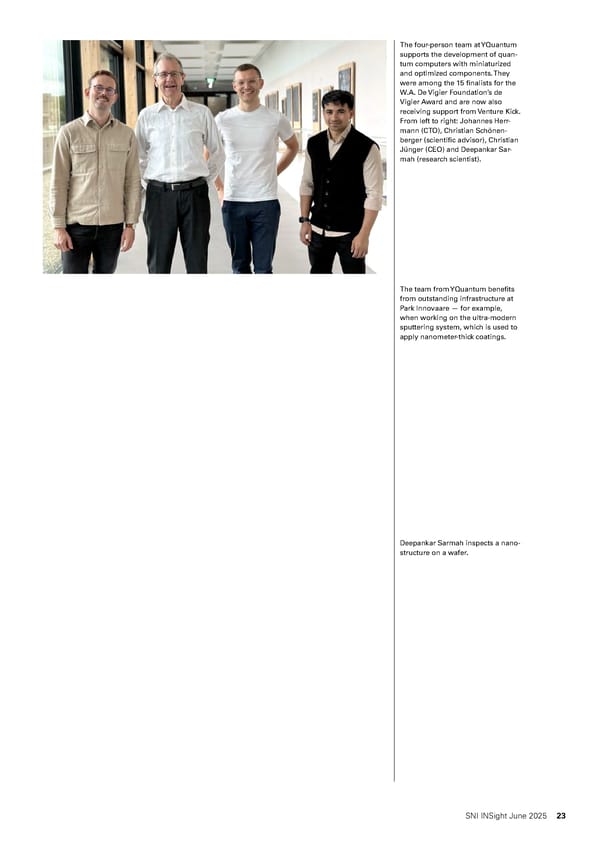
“Founding a company like this is really exciting. Every day’s different — and it’s great when months of work culminate in supplying a product that helps others solve a problem.” Dr. Christian Jünger on the first few months as a cofounder of YQuantum rent approaches. This also means that more components such as filters and am- plifiers will need to be integrated into the cryostats. That’s where we come in — be- cause we offer smaller, optimized compo- nents, all of which are scalable.” Already available YQuantum already has two products on the market and is currently supplying them to its first customers. One of the products is a DC block — a small device that provides clean and controlled grounding, thereby eliminating un- wanted electrical currents that could dis- tort measurement results or interfere with sensitive qubits. The other product offered by YQuantum is a bias tee, which can, for example, be used to supply a com- ponent with electricity while simultane- ously controlling it via high-frequency signals without the two signals interfer- ing with one another. “This component ensures that communication between two qubits achieves a higher quality fac- tor,” says Jünger. “It also allows us to im- prove quantum computing, although we often have to do a bit of educating — be- cause some users aren’t aware of the im- perfections of their current solutions.” YQuantum has applied for a patent on this integrated IR filter, which removes noise effec- tively and reproducibly and therefore leads to improved quantum signals. It is also sig- nificantly smaller than existing systems. Partner in a Nano-Argovia project Since the start of this year, YQuantum has also been participating as an industrial partner in a Nano-Argovia project. To- gether with researchers from the Univer- sity of Basel and the Paul Scherrer Insti- tute, the team is developing an amplifier that converts weak signals from a quan- tum computer into classical electrical sig- nals without additional noise, paving the way for precise and scalable quantum control. “We have plenty of other ideas about which components we can optimize and miniaturize in order to make quantum computers faster, more stable, and scal- able,” says Jünger. Most of the projects are initially designed for superconduct- ing quantum computers, but they can generally also be used for other concepts, such as the spin-based quantum com- puter that is the subject of research at the University of Basel. In developing these innovative con- cepts, the young entrepreneurs apply knowledge they acquired in various world-leading research groups in Switzer- land and the USA. Through a combination of quantum physics, nanoscience and en- gineering, they are ensuring that the whole is greater than the sum of its parts. Although the company name is pro- nounced “Why Quantum?”, that is actu- ally no longer the question for this four-person team of scientists. These days, they’re more interested in how quickly powerful quantum computers can be developed and how YQuantum can support its customers with the develop- ment process. Further information: YQuantum 24 SNI INSight June 2025
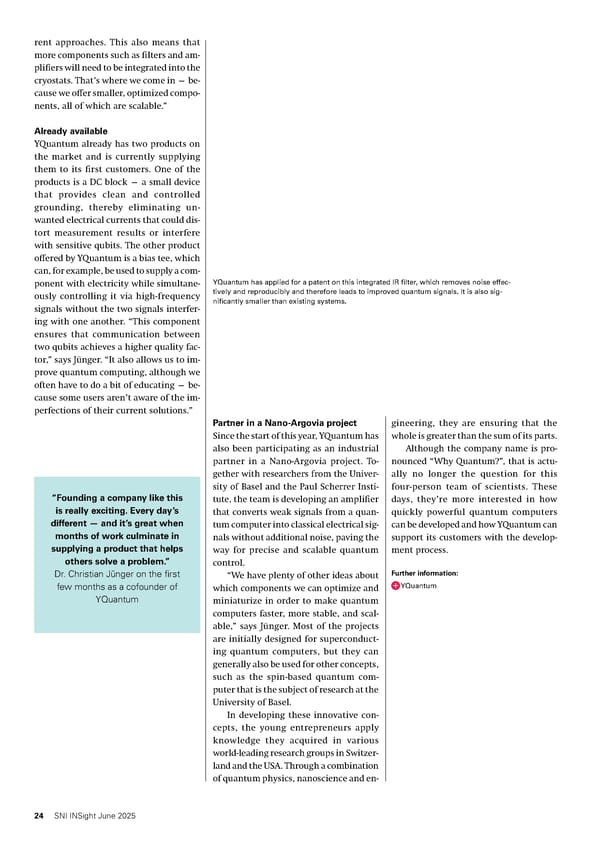
Awards and promotions Ilaria Zardo made full professor The University Council has retroactively promoted Professor Ilaria Zardo to full professor as of 1 Febru- ary, 2025. Zardo has been Professor of Experimental Material Physics at the Department of Physics of the University of Basel since 2015 and is also head of the Nano Technology Center of the SNI, as well as being a member of the SNI Executive Commit- tee. Her research focuses on the investigation of phonons, as she explains in a video about her work. Video with Ilaria Zardo about her research Ilaria Zardo was promoted to full professor. Andrea Hofmann receives Wolfgang Mehr Fellowship Award 2024 In February, Professor Andrea Hofmann received the Wolfgang Mehr Fellowship Award, which is pre- sented annually by the Leibniz Institute for High Performance Microelectronics (Frankfurt an der Oder, Germany). Hofmann received the award in recognition of her outstanding contributions to the field of semiconductor physics. Post Leibniz Institute for High Performance Microelectronics Video with Andrea Hofmann about her research Andrea Hofmann was honored with the Wolfgang Mehr Fellowship Award. Oliver Germershaus becomes head of Institute for Pharma Technology and Biotechnology Prof. Oliver Germershaus took over as Head of the Institute of Pharmaceutical Engineering and Bio- technology (FHNW School of Life Sciences) from Prof. Georgios Imanidis in April 2025. News from FHNW University of Applied Sciences and Arts Since April 2025, Oliver Germershaus has been Head of the Institute of Pharmaceutical Engineering and Biotechnology. (Image: FHNW) Anna Leder receives Biozentrum doctoral prize Former nanoscience student Anna Leder, who is cur- rently writing her doctoral thesis with Prof. Sebas- tian Hiller (Biozentrum), was awarded the J.C.W. Shepherd Doctoral Prize for her excellent scientific achievements at the Biozentrum Symposium 2025. She was honored for a publication that will soon be published. SNI post Former nanoscience student Anna Leder received the Biozen- trum’s doctoral prize. 25 SNI INSight June 2025
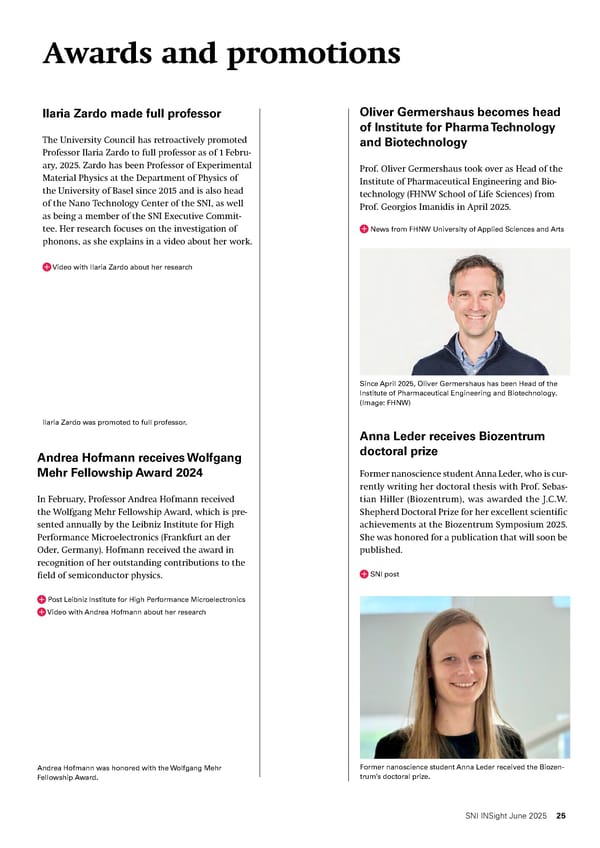
Network Funding for SNI members In recent months, new funding has been awarded to researchers from the SNI network. Here, we set out a few examples to give a general idea of the areas in which our members are active with a view to encouraging interdisciplinary exchange between different research groups. Focus on photochemistry In April 2025, the group led by Professor Oliver Wenger (Department of Chemistry, University of Basel) began a new four-year SNSF project on photochemistry. The proj- ect deals with key questions of photo- chemistry and in particular with hard- to-understand reaction mechanisms and the targeted control of photochemical processes. It aims to gain a better under- standing of the elementary steps from light absorption to product formation and to use this knowledge to develop efficient, specifically controllable photochemical reactions. A faster and more efficient method At the beginning of the year, the team led by Professor Konrad Tiefenbacher (Department of Chemistry, University of Basel) began a Spark project aimed at simplifying certain chemical reactions (polyene cyclizations). Until now, these reactions have entailed several complex steps that ultimately lead to the forma- tion of methylated cyclic molecules. The team of researchers now wants to use a methyl cation donor to make polyene cy- clization possible in a single step. They believe that this reaction, which has not yet been realized in practice, has consid- erable innovative potential and paves the way for efficient access to new and well- known fragrances from simple starting materials. Differences between women and men in heart diseases At the end of last year, Prof. Dr. Anna Marsano (Department of Biomedicine, University of Basel) and Dr. Karin Wildi (University Hospital Basel) launched a re- search project with the aim of improving the identification of heart disease accord- ing to sex. Cardiovascular diseases, such as myocardial infarction, are the leading cause of death in both women and men. However, women tend to develop these conditions later in life. The use of identical clinical decision thresholds, based on specific cardiac biomarkers, for diagnosing men and women may hinder early detection and treatment in women. In this four-year project, the team will investigate how sex, hormones (such as estrogen), and other factors influence car- diac biomarkers and cell damage. To achieve this, the researchers will analyze patient data and use advanced cell models that simulate biological differences be- tween men and women, including pre- and post- menopausal states. Spatially distributed quantum entanglement of ultracold atomic clouds As part of a new SNSF project starting in October 2025, the group led by Professor Philipp Treutlein (Department of Physics, University of Basel) will investigate how quantum entanglement can be generated between multiple spatially separated ul- tracold atomic clouds. The researchers first trap ultracold rubidium atoms in a magnetic trap on a microchip. Controlled collisions then create entanglement be- tween the over 1,000 atoms in the cloud, and the researchers split the ensemble into multiple clouds at different spatial locations. These clouds can be controlled and detected individually. Systems of this kind pave the way for studying the foun- dations of quantum physics and for appli- cations in electromagnetic field imaging. Nanopores to diagnose infectious diseases Along with several other partners, Dr. Maurizio Gullo (FHNW School of Life Sci- ences) is participating in VarioPore, a new cross-border Interreg project in which researchers are developing innovative di- agnostic technology for the quick and accurate detection of infectious diseases such as Lyme disease. This work focuses 26 SNI INSight June 2025
on the use of nanopores — tiny pores in membranes that allow the detection of individual molecules with no need for marking. When a molecule migrates through a pore of this kind, it changes the flow of electric current, and this change serves as a characteristic signa- ture for the molecule, allowing it to be identified. The project is scheduled to run for two years and involves researchers from Ger- many, France and Switzerland — both from higher education institutions and from industrial companies. Furtwangen University coordinates the project, while the FHNW School of Life Sciences is re- sponsible for the project in Switzerland. Recording molecular interactions A Propelling Grant from the University of Basel was recently awarded to three young researchers from the team of Ar- govia Professor Roderick Lim. Mitchell Brüderlin, Lukas Beckert and Dr. Kevin Nils Baumann want to investigate non- specific molecular interactions that con- tinue to present a major challenge when it comes to achieving precision on the nanoscale. With REsolve, they plan to de- velop a modular single-molecule plat- form in order to measure and control these interactions with unprecedented specificity and flexibility. Brüderlin and Beckert are currently doctoral students at the SNI PhD School, while Baumann is working as a postdoc in Lim’s team. Thanks to the Propelling Grant, the three researchers will receive not only financial support but also an ex- cellent platform for reinforcing the busi- ness model, identifying a customer base and taking the project to the next level with help from the team at the Innova- tion Office of the University of Basel as well as a network of mentors. New research center for stable quantum bits In March 2025, the universities of Basel, Bern and Salzburg founded the “Center for Molecular Quantum Systems” (MolQ) with support from the Werner Siemens Foundation (WSS). At the WSS Research Center, researchers will develop novel su- perconducting qubits with topological pro- tection by following a promising approach to achieving powerful, interference-resis- tant quantum computers. As part of this Oliver Wenger and his group started a new SNSF project on photochemistry in April 2025. He was also recently awarded an ERC Advanced Grant – which we will report on in the next SNI INSight. Further information on the various projects: SNSF Oliver Wenger Research group Oliver Wenger SNSF Konrad Tiefenbacher Research group Konrad Tiefenbacher SNSF Anna Marsano Research group Anna Marsano SNSF Philipp Treutlein Research group Philipp Treutlein Interreg VarioPore Research group Maurizio Gullo Propelling Grant Media release Universität Basel MolQ Webpage MolQ work, physics, chemistry and theory meet innovative molecular materials that are tested at low temperatures. The aim is to lay the foundation for scalable and ener- gy-efficient quantum computers. To this end, the researchers will de- posit newly developed molecules with a spin on superconductors in order to pro- duce a new topological superconductor. The topology should mean that quantum states in this system are better protected and have a longer coherence time than those in other quantum systems. From the University of Basel, the participating groups are those led by Professors Ernst Meyer, Jelena Klinovaja, Daniel Loss and Dominik Zumbühl. The Werner Siemens Foundation is supporting this interdisci- plinary project with CHF 15 million over a period of 11 years. 27 SNI INSight June 2025
News from the SNI network Damaged but not defeated Bacteria use nano-spearguns to retaliate against attacks Some bacteria deploy tiny spearguns to retaliate against attacks from rivals. Researchers at the Uni- versity of Basel mimicked attacks by poking bacteria with the tip of an atomic force microscope (AFM). Using this approach, they discovered that the bacte- ria only assemble and deploy their nanoweapon if their cell envelope is damaged in an attack. Mitchell Brüderlin, a doctoral student at the SNI PhD School, was principally responsible for carrying out this work in the groups led by Professors Marek Basler and Roderick Lim (Biozentrum, University of Basel) and was first author of the publication in Science Advances. SNI post with video Original publication Origami-based artificial heart tissue As part of a Nano-Argovia project, researchers from the SNI network have developed a new method for producing artificial heart tissue. In the form of a plas- ter, this multi-layered tissue could support the heal- ing process of dead tissue in the event of a heart attack, for example. The researchers from the FHNW School of Life Sciences, the University of Basel and the industrial partner Omya AG recently published their results in the journal ACS Biomaterials Science & Engineering. SNI post Original publication As part of his doctoral thesis at the SNI PhD School, Mitchell Brüderlin inves- tigated how bacteria defend themselves against an attack. Researchers have grown a multi-layered, functional artificial heart tissue. To do so, they structured a paper scaffold made of cellulose with a micro and macro pattern. The heart muscle cells aligned themselves based on the microstructure (background, right), while the macrostructure caused the tis- sue to fold (heart model, center). Overall, the researchers were able to sig- nificantly improve the contractility of the tissue. (Image: FHNW and University of Basel, CC BY-NC-ND 4.0) 28 SNI INSight June 2025
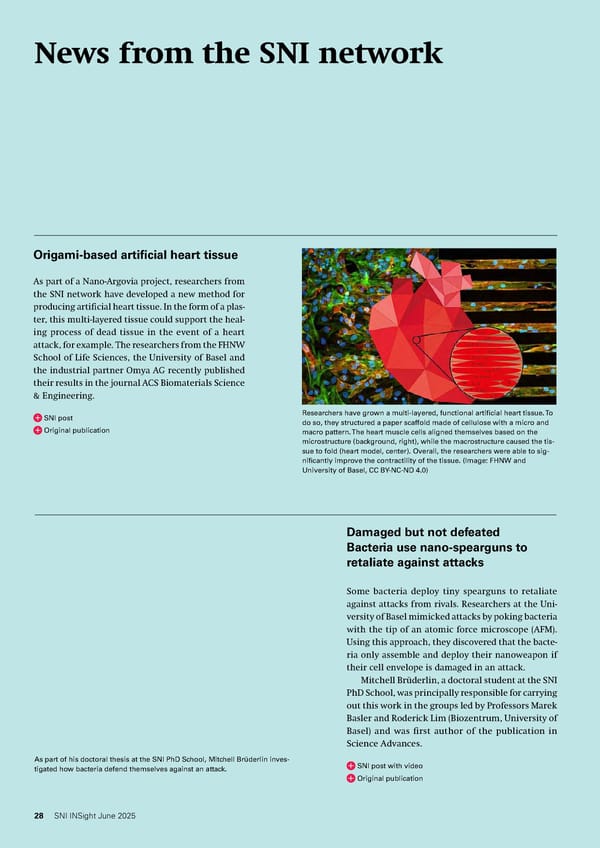
New methods for the characteriza- tion of bioconjugated nanoparticles Researchers from the SNI network have developed two new spectroscopic methods for the quantitative determination of functional surface groups on metal oxide nanoparticles — a key prerequisite for targeted bioconjugation with biologically active molecules such as antibodies. These methods are based on flu- orescence or UV-Vis spectroscopy and were success- fully tested on hafnium oxide nanoparticles. The studies were carried out and published by SNI doc- toral student Elizaveta Maksimova, from the group led by Professor Jonathan de Roo, in collaboration with group colleagues. SNI post Original publication Researchers from the SNI network developed two new spectroscopy meth- ods to quantify functional groups on the surface of metal oxide nanoparti- cles. (Electron microscopic image: Department of Chemistry and Nano Imaging Lab, University of Basel) Video on World Quantum Day As part of this International Year of Quantum Science and Technology, we marked World Quantum Day on 14 April with a behind-the-scenes look at quantum research at the University of Basel. In this short video, researchers from the Department of Physics of the University of Basel explain which areas of quantum science they work in and why this research wouldn’t be possible without nanoscience and nan- otechnology. Video “Quantum needs Nano” In the short video, various researchers from the SNI network explain why they need “nano” for their quantum research. International Women’s Day To celebrate International Women’s Day on 8 March, we published a video with Professor Andrea Hofmann (Department of Physics, University of Basel) in which the young physicist talks about her research into transport within semiconductors, which contributes to the creation of qubits. Video about the research of Andrea Hofmann SNI post Andrea Hofmann describes her research on transport in semiconductors in a short video. 29 SNI INSight June 2025
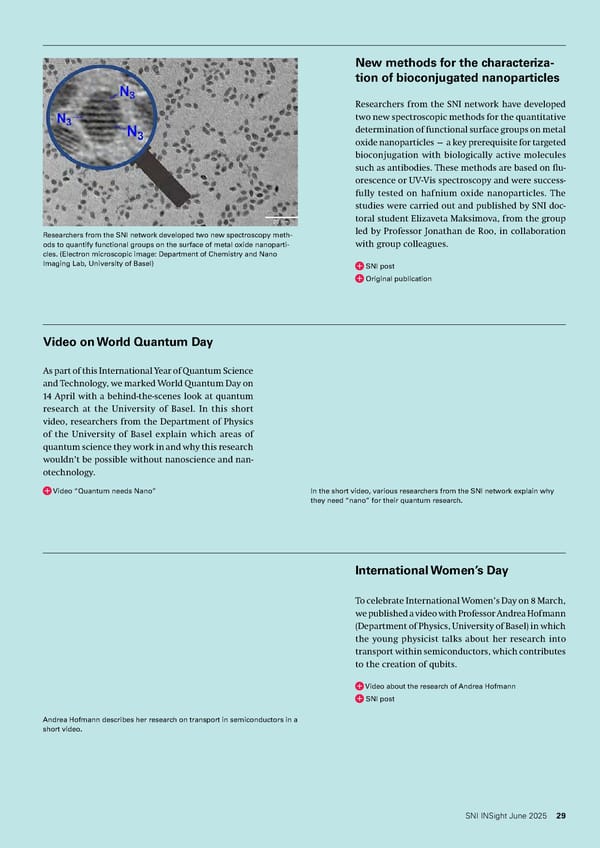
Ilaria Zardo explains her research on phonons in a short video. International Day of Women and Girls in Science On 11 February, 2025, we celebrated the International Day of Women and Girls in Science. Given that 2025 is also the International Year of Quantum Science and Technology, what better way to celebrate than by speaking to a female scientist who can act as a role model for many women and who carries out research at the interface between nano and quantum sciences? In a short video, Professor Ilaria Zardo ex- plains her research in the field of nanophotonics at the Department of Physics of the University of Basel. SNI post with the video about the research of Ilaria Zardo Inspiring User Event from the Nano Imaging Lab This year’s User Event was attended by around 50 people, who gained fascinating insights into current research projects in collaboration with the SNI’s Nano Imaging Lab (NI Lab). With contributions from various participants, the event showcased the NI Lab’s wide-ranging applications in impressive fash- ion — from cryo-focused electron-beam deposition and magnetic force microscopy to biomedical appli- cations. Industry representatives were also on hand, with Delta Mem AG and ANAXAM demonstrating how electron microscope analyses contribute to product optimization. We’re already looking forward to the next event on 7 April, 2026. SNI post The informative Nano Imaging Lab’s User Event in April 2025 attracted around 50 participants. Marcus Wyss took colleagues from the general vocational school (Allge- meine Gewerbeschule) of Basel on a journey into the micro and nanoworld. (Images: Nano Imaging Lab, SNI, University of Basel) Tiny worlds, big impact Real-time microscopy inspires col- leagues At the end of April, Dr. Marcus Wyss, head of the Nano Imaging Lab at the SNI, was visited by col- leagues from the mechanical engineering team of the general vocational school (Allgemeine Gewerbe- schule) of Basel. Wyss, a nanoscientist and continu- ing education teacher, introduced his colleagues to the activities of the Swiss Nanoscience Institute at the University of Basel. He reported on various re- search projects of the Nano Imaging Lab (NI Lab), as well as giving the visitors an introduction to scan- ning electron microscopy. SNI post 30 SNI INSight June 2025
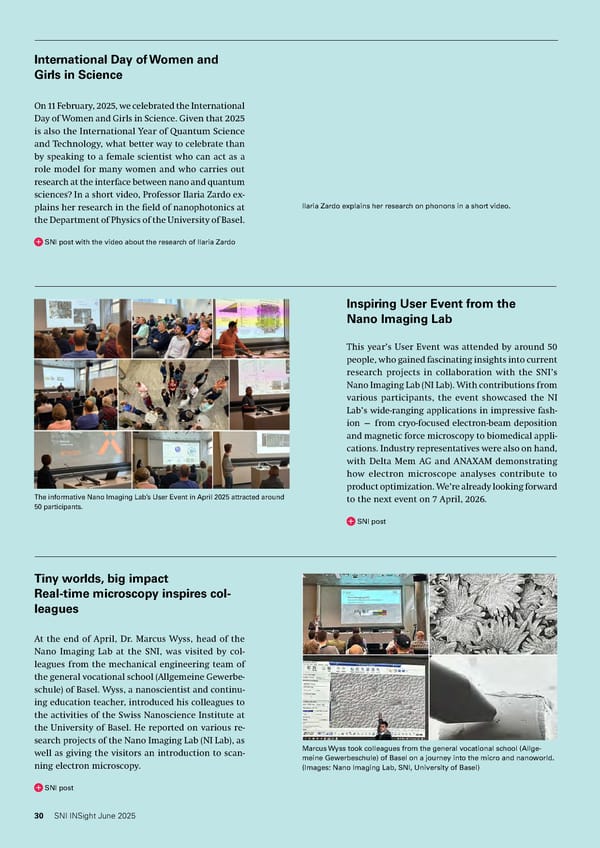
During the ANAXAM visit, nanoscience students also had a look at the Swiss Light Source Synchrotron at the Paul Scherrer Institute. (Photo: N. Stebler, SNI, University of Basel) More than just a quantum leap ahead A behind-the-scenes look at indus- try for nanoscience students During the course “Applications of Nanosciences in Industry,” students have the chance to get to know different companies and research institutions. The aim of the course is not only to impart theoretical knowledge, but also to provide students with direct insights into the world of industry and therefore to highlight specific career prospects with a view to their future professional development. Former nanoscience student Nadya Stebler ac- companied students on one of these excursions to the ANAXAM technology transfer center and subse- quently wrote a report for the University of Basel’s Campus Stories. Campus Stories, University of Basel Fascinating insights into the nanosciences Students impress at “Small Talk” Our nanoscience bachelor’s students have once again organized a successful “Small Talk” — their own small-scale nanoscience conference in Basel! In talks and a poster session, the students pre- sented the results of the block courses that they have completed at various departments and institutions in recent months. The presentations were reviewed by researchers from the Departments of Physics or Chemistry and the Biozentrum — who were once again impressed with their excellent quality. Thank you to everyone who attended! The two posters by Linus Wesp and Eduard Basler, who both won the prize for the best poster, were particularly outstanding! Basler also won the prize for the best oral presentation, while Sarah Vogel won the prize for the best poster design. Congratulations! SNI post Excellent presentations and inspiring discussions at the posters - the “2025 Small Talk” event was once again a success. 31 SNI INSight June 2025
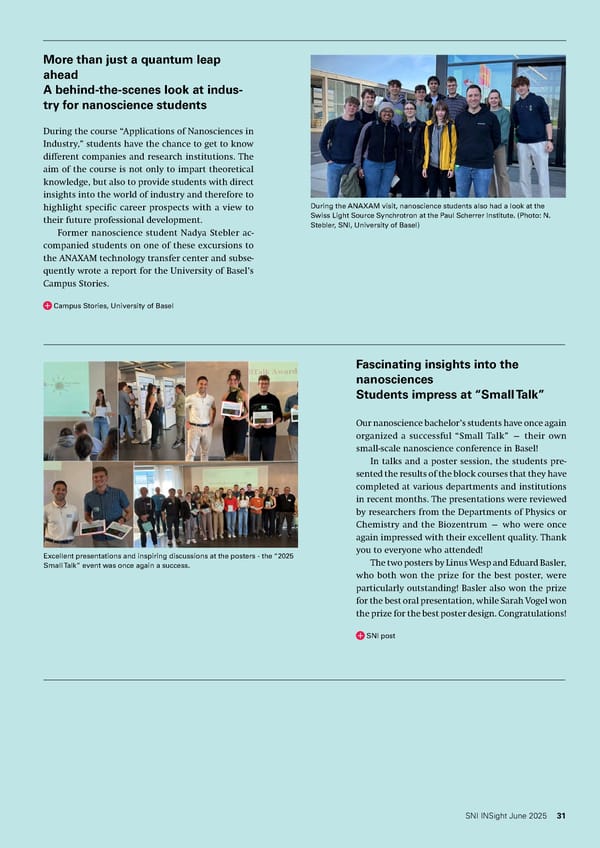
Colors without dyes Hands-on science at the phaenovum Open Day in Lörrach On the last Saturday in May, we participated in the open house at the phaenovum Lörrach student re- search center. Overall, it was a successful event, with many interested children, pupils and parents in at- tendance. In addition to providing information about studying nanoscience at the University of Basel, the SNI stand offered colorful chocolate that didn’t con- tain any dyes. SNI post Schülerforschungszentrum phaenovum Lörrach At the Open Day of the phaenovum student research center in Lörrach, the SNI team provided both colorful chocolate and information about structural colors. Science meets art SNI participates in a creative work- shop at the Cartoonmuseum Basel This year, as part of the IBSA Foundation’s Let’s Science initiative, the team from the Swiss Nano- science Institute (SNI) has taken the opportunity to explore the fascinating links between science and art with pupils from various schools at the Cartoon- museum. The first event was held on 1 April with Dreirosen primary school and was a huge success. The three following workshops also offered a good opportunity to present science from a different an- gle. Video impressions Science and art are often closely related. During the first half of 2025, the SNI explored this connection with pupils of different ages at the Cartoon Museum. 32 SNI INSight June 2025
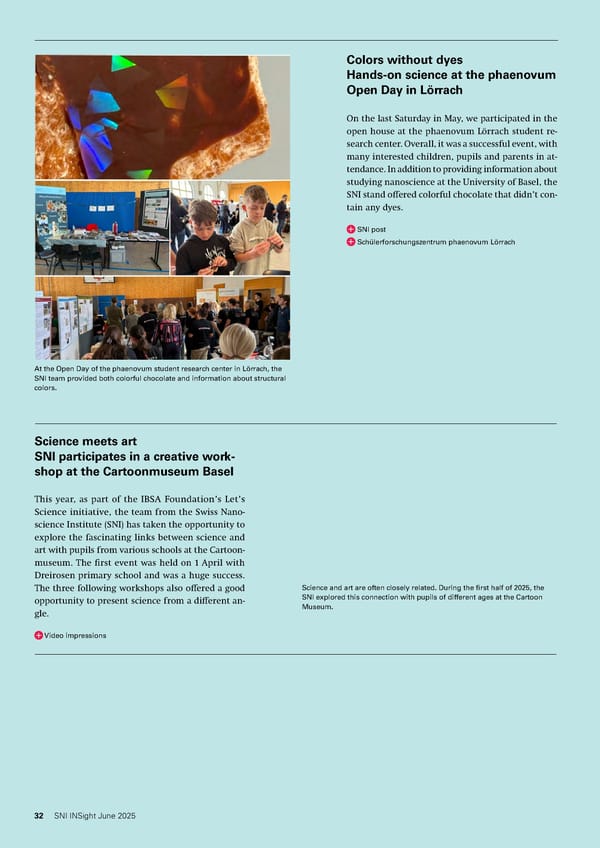
SNI INSight Showcasing research and activities of the Swiss Nanoscience Institute About this publication: Design concept: STUDIO NEO Concept, text and layout: C. Möller, B. Utinger, M. Poggio Translations and proofreading: UNIWORKS (Erlangen, Germany) Image credits: C. Möller and named sources © Swiss Nanoscience Institute, June 2025 Cover image: As part of a Nano-Argovia project, researchers are applying wafer-thin coatings using a state-of- the-art sputtering system at Park Innovaare. 33 SNI INSight June 2025
University of Basel Petersplatz 1 Postfach 2148 4001 Basel Switzerland www.unibas.ch Swiss Nanoscience Institute Universitat Basel Klingelbergstrasse 82 4056 Basel Switzerland www.nanoscience.ch Educating Talents since 1460.

